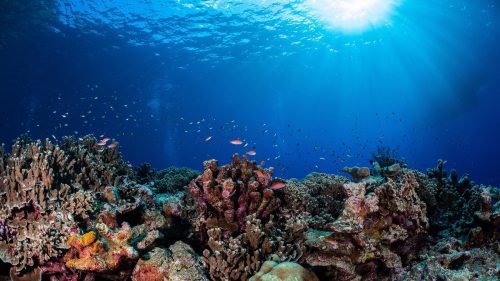North Pacific Ocean basin: a Detailed Map

The ocean is one huge body of water that covers about 71% of the Planet’s surface; its waters are connected throughout the globe (therefore it is also called the Global Ocean), yet human beings have come to split it into five main basins based on historical, geographical, and cultural factors.
These water bodies are known as the Pacific, Atlantic, Indian, Arctic and Southern Ocean basins. Combined, they contain about 97% of all the water on Earth.
Ocean basins can be further divided into smaller sections. For example, as the Pacific Ocean basin is the biggest, in this article we will focus only on its Northern part: the North Pacific.
We will learn about its position, details, and geology, as well as its ecosystems and biodiversity and the essential role they play in the balance of life on Earth.
If you want to learn all you need to know about the North Pacific, you’re in the right place.
Where is the North Pacific?
The North Pacific in the part of the Pacific Ocean basin that lies North of the Equator. It stretches from the Eastern coasts of Asia to the Western Coasts of North and South America (until the Equator) and extending northward to the Arctic region.
How deep is the North Pacific?
The deepest spot in the North Pacific is known as the Challenger Deep in the Mariana Trench, at a depth of 11,034 m (36,201 ft). It is the deepest recorded point in the world, located east of the Philippines.
An Oceanic Trench is a long and narrow topographic depression of the ocean floor, usually found at the convergence of plate tectonics.
Fun fact, Mount Everest would fit in the Challenger Deep with over a mile to spare!
Climate
In the North Pacific, conditions are not as uniform as they are in the southern part of this massive body of water.
Specifically, in the North, there are considerable differences between the eastern and western regions in the same latitude: the extreme temperatures that characterize the winters off the east coast of Russia, for instance, contrasts sharply with the relative mildness of winters in British Columbia.
Moreover, the North Pacific is warmed by an extension of the Kuroshio (Japan Current) and has a positive anomaly of 4 to 6 °C (39,2 to 42,8 °F) warmer than the average for its latitude. This warmth, however, does not penetrate inland, due to the blocking influence of the Cordilleras.
Salinity
The North Pacific can be distinguished from other ocean basins by several unique characteristics. One of these is being host to the lowest surface salinities globally. In the North Pacific, the maximum salinity rarely reaches 36 parts per thousand.
The low salinity can inhibit deep-water formation at high latitudes and may limit heat transport towards the pole.
Since there are no major rivers draining to the North Pacific, the source of the low surface salinity can be traced back, at least in part, to the heavy rainfall of the Intertropical Convergence Zone (ITCZ).
Temperature
The ocean is stratified, and one of the main factors of this stratification is temperature: the bottom waters, which contain about 80% of the ocean’s volume, are very cold, with stable temperatures just above freezing, usually around 3.5 °C (38.3 °F).
In the surface zone, on the other hand, up to a depth of around 300 meters (1,000 feet) temperatures vary greatly.
Usually, water temperatures in the North Pacific are slightly higher than those in the South Pacific. This is due to land to sea ratio, and to Antarctica’s and the Southern Ocean basin’s influence.
Physiographic Regions
The Pacific water basin can be conveniently divided into three major physiographic regions: the western, eastern, and central Pacific regions.
Eastern region
The eastern Pacific region stretches southward from Alaska to Tierra del Fuego. It is relatively narrow and is associated with the American Cordilleras, which rise steeply from the western shores of both North and South America.
In the North Pacific, the most important oceanic trench in this region is the Middle America Trench.
Western region
The western Pacific region is separated, in the east, by a line of oceanic trenches extending from the Aleutian Trench in the North, through the Kuril and Japan trenches, all the way to the Tonga and Kermadec trenches, which end near North Island, New Zealand.
The structure of this region is more complex than that of the Eastern region. Many of the islands found here, including Japan, are the upper parts of mountain systems that rise steeply from the ocean floor.
Central region
The Central Pacific region lies between the boundaries of the Eastern and Western regions. It is the largest and the most geologically stable of the structural areas of the Earth’s crust, and is characterized by huge areas of low relief, lying at an average depth of about 4,600 meters (15,000 feet).
Biodiversity
Of all the world’s oceans, the Pacific boasts the most diverse marine biodiversity. This is because the currents that go connect the southern and northern polar waters of the Pacific allow the mixing of life forms coming from other oceanic regions.
One of the main features of this variety is given by the kelp beds found on the rocky cold-water coasts of North and South America. These forestry environments are home to a great range of marine life, from invertebrates to fishes, and have an animal biodiversity almost as varied as that of the rainforests.
In the tropical climates of the Western Pacific, the wealth of marine animals obviously increases exponentially, and here we can find the richest and most extensive coral reefs of the planet.
Whales, sea turtles, sea otters, and sea lions are a prominent and spectacular component of Pacific marine life.
Geology
Research has shown that all the major features of the Pacific Ocean basin floor and the land that surrounds originate in plate tectonics.
For example, the arcs of volcanic islands and deep trenches in the Western part of the Pacific are convergent zones where two plates are colliding, forcing one under the other.
On the other hand, the East Pacific Rise is an active spreading centre, which is where new crust is created.
In the south-eastern Pacific, the Nazca Plate and the South American Plate collide to form the Andes Mountains and, a short distance offshore, the Peru-Chile Trench. The floor of the north-eastern Pacific is known for its various fracture zones, which, in some cases, are identifiable over great distances. The tropical islands of the Pacific are mostly coralline.
Mineral resources
The Pacific Ocean basin contains enormous mineral resources of which only a few have been exploited, like salt, bromine, and magnesium. Minerals can be extracted from the seawater itself, from alluvial deposits, or from the continental shelf. Underwater exploration for oil has also occurred near Vietnam, the Philippines, Indonesia, California, Russia, and China. There are also known deposits of natural gas in the continental shelf of both the northern and southern hemispheres.
Fresh water can also be obtained from the ocean, by various methods of desalination, as is done in Japan.
Threats
As the whole Pacific Ocean basin, the North Pacific is under threat.
One of the main issues, as it is now clear, is marine pollution, mainly plastic and other debris.
In the Pacific, we find the largest garbage patch, also known as the “Great Pacific Garbage Patch”, which is a huge plastic accumulation area found at the centre of an ocean gyre (a rotating ocean current).
Pollution is mainly caused by littering, maritime transportation (90% of global trade currently uses sea routes), mining and drilling, oil spills and ocean dumping (the direct discharge of pollutants in the ocean from industries, ships, or sewage plants).
Other serious threats to the balance of the Pacific Ocean basin are overfishing and illegal fishing practices, which destroy marine ecosystems and leave behind an incredible number of harmful debris.
References
https://www.britannica.com/place/Pacific-Ocean
https://www.eionet.europa.eu/gemet/en/concept/5695
https://www.sciencedirect.com/topics/earth-and-planetary-sciences/north-pacific-ocean



